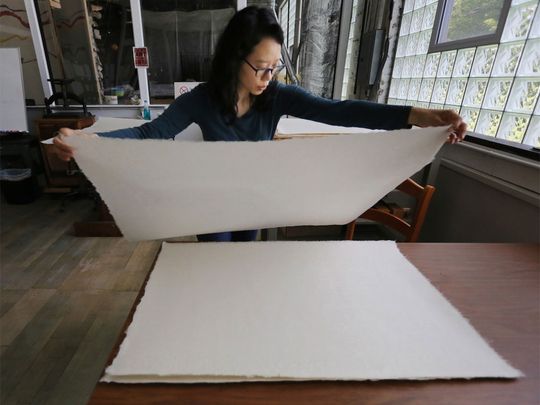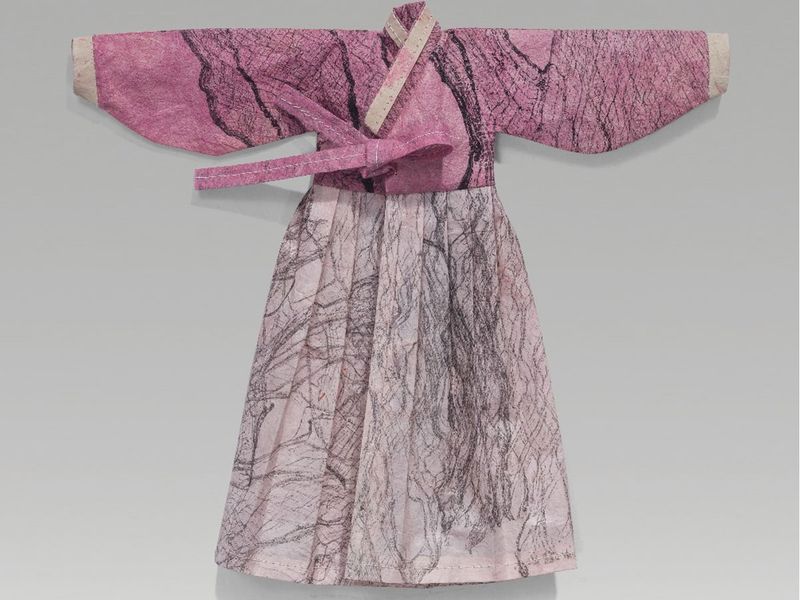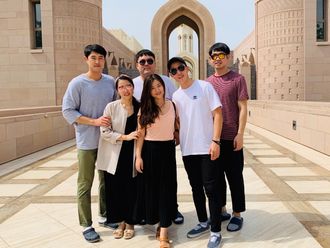
Dubai: In a world of digital and modern art, Korean-American artist Aimee Lee has one mission – to preserve and revive Hanji, a fading 2000-year-old craft of making objects using traditional Korean handmade paper.
Artworks by the award-winning Hanji artist are currently displayed in the UAE, in an exhibition titled ‘Aimee Lee: From Milkweed and Mulberry, One Papermaker’s Seasons’, organised by the Embassy of the Republic of Korea to the UAE and the Korean Cultural Center.
What is Hanji?
The word ‘Hanji’ literally translates to ‘Korean paper’, in English. This paper is harvested from the inner bark of the mulberry tree, and, despite its delicate appearance, it is known for its extreme durability.
However, the traditional Korean paper that was once renowned in Asia for its sturdiness, is now produced only in a handful of rural paper mills. There are only around 20 workshops in Korea that continue to produce high-quality Hanji through the centuries' old labour-intensive papermaking technique called webal. A practice that dates to somewhere between the third and sixth centuries.

Lee, who has also authored many books about Hanji art, has mastered every step of it – from making the paper to creating art out of it.
Her artworks draw inspiration from ancient Korean artifacts, materials, skills, and tools, combining them with her contemporary artist training and papermaking expertise. Thanks to the durability of the Hanji paper, some of the artwork she produces are wearable.
In an exclusive interview with Gulf News, the artist explained why she chose Hanji as her tool for creative expression.
“I have spent over 15 years researching Hanji as an artist, and one of the most important things that I do is directly make and use Hanji to make my art. This makes it special to me because it is a way to create expressive art while using materials from my heritage and sharing it with the public, in hopes not only of communicating with them through my art but enlightening them about Hanji,” Lee said.

Inspiration to learn the ancient technique
Today, Aimee Lee is considered a leading Hanji scholar and practitioner, but it was an art history class during her undergraduate studies, where she discovered the magic of the ancient papermaking technique.
“I studied visual art as my undergraduate major. During a Chinese landscape painting art history class, we visited the campus museum at Oberlin College and the curator unrolled a scroll to show us a painting, which he said was painted on Korean paper, because Chinese artists preferred it over Chinese paper,” Lee recalled.
She suddenly realised that she didn’t know much about the Korean paper, and if she wanted to learn, she would need to reconnect with her language and heritage.
“I started to speak with my parents in Korean instead of English. I also went to Korea to study the language and spent time with my extended family there.”
It bothered Lee that Hanji was often ignored when art students would learn the world history of handmade paper.
“When I studied hand papermaking in graduate school, I noticed in papermaking history—at least taught in English—we only learnt that the Chinese invented papermaking, then it travelled to Korea, then Japan.
“Most Americans only know Japanese paper and think it is the only or best Asian paper. But because I was born in the US to Korean immigrant parents and knew how it felt for Korea to be left out of the conversation.”
Hanji has a significant role in the history of papermaking and printing.
The Great Dharani Sutra, a scripture of Mahayana Buddhism, which is one of the oldest printed texts in the world, is printed on Hanji.
According to British biochemist and historian Joseph Needham, the text, which was discovered in 1966, was originally made between 684 and 704 and is one of the oldest woodblock prints (on Hanji) in the world.
“I wanted to learn the history of Korean papermaking. The best way to do that was to learn from master papermakers and paper artisans in Korea,” Lee said.
Lee began learning how to make Hanji from scratch.
“Later in graduate school, I was able to conduct all my research in Korean language. There are so many things that Koreans did with Hanji in the past. Not only was I able to learn how to make it, but also the techniques for natural dyeing, texturing, fusing, cording, twining, and calligraphy—all using Hanji as the main element.”
How Hanji is made
Now, Lee makes Hanji for her crafts and teaches students, apprentices, and assistants.
“It is best, like any labour, to work together to make Hanji,” Lee said as she explained the entire process.
“It is a very long, laborious process like farming—in fact, traditionally, farmers in the winter made Hanji. Making Hanji is not much different from growing plants for food. You must first cultivate paper mulberry trees, scientifically called Broussonetia papyrifera. The trees get harvested in winter.

“Next, you steam the shoots, strip the bark, scrape away the outer bark layers, and cook the remaining white bark in potash that you make from burning other plants, rinse, pick out any impurities by hand, and beat fibre by hand with wooden bats. Then you create mucilage from another plant to add to the vat, mix the vat full of water with fibre and mucilage, and form sheets. You press excess water away, part and board the sheets, wait for them to dry, and then hammer for maximum smoothness.”
Revival of traditional arts
Lee, who has travelled to many countries across the world for Hanji exhibitions and workshops, said that she always noticed how Hanji objects made people curious about the traditional technique.
“I think there is more of an interest in traditional art because people are looking for something that they can feel connected to. It is impossible not to want to reach out and touch Hanji, or even my Hanji art. While in a gallery setting, the audience should not touch the artwork, I know why people instinctively reach out to do it. The paper is Nature, it is plants transformed. We are Nature and want to be in connection, and most people have not had direct experience with high-quality handmade paper. They cannot believe that the art is made from 100 per cent paper.”
Climate change and cultural exchange are two other reasons people want to understand the technique, she added.
“With serious and warranted concerns about climate change, but also cultural change—how everyone is more distant and isolated, lonely in this digital age—people want to learn more about what artists in the past did, because we have so much to learn from those techniques.”
Hanji is one of the most sustainable papermaking processes, Lee highlighted. “This is the way that paper was made since the beginning of papermaking history. At that time, people did not have electricity or extract fossil fuels from the earth. They used methods like weighing bark with rocks in clear mountain streams to rinse naturally, or bleach naturally in the sun and snow instead of using harsh chemical bleach. There was no way not to be sustainable because people lived and worked very close to nature. It is not hard to go back centuries to see that the old way of working made the least impact on the environment.
“Now, with all of our resources, we can learn these traditional arts while evolving them with current ideas and methods to keep them alive,” Lee added.
Hanji used for art restoration
Thanks to scholars like Lee, there seems to be a revival of the use of Hanji in the art industry.
According to a 2021 Korea Times article, in 2016, the Central Institute for the Restoration and Conservation of Archive and Book Heritage (ICRCPAL), an Italian research institute, officially recognised two types of Hanji as suitable material for the conservation of European documentary heritage. It adopted Korean paper for the restoration of Italian cultural heritage, including the Chartula of St. Francis of Assisi, Rossano Gospels, and a globe owned by Pope John XXIII (1881-1963).
France's Louvre Museum also began employing Hanji to restore a relic from its collection in 2017, specifically for a damaged handle ornament of an antique writing desk from 19th-century Bavaria that belonged to King Maximilian II.
Hanbok with hanji
Lee added that Multi, a large hanbok that she created, was one of the artworks she feels most connected to. It is displayed at the ongoing exhibition in Abu Dhabi.
“Hanbok literally translates to ‘Korean clothing’ and these forms also connect to my heritage,” she said.
“Multi is made from many different pieces of hanji that I have made over the years. It is one of the pieces that I feel most connected to because they require much more labour or planning to execute. Some [pieces used in the Hanbok] are even recycled from older art that I have made, exhibited widely, and then taken apart to turn into new work. This is the beauty of paper: It can be recycled over and over, and eventually completely pulped to make new paper. I used the bark of the tree that makes the Hanji to also create the patterns, by cooking, spreading, and drying the ensuing latticework that I call bark lace. I use etching ink to roll onto the flat bark lace and send it through an etching press to print the lacy pattern onto paper that I have made and dyed. After many prints, I can cut pieces apart and sew them together again, to create this dress.
“I have many students who come from different backgrounds but want to connect to Hanji. This piece is an homage to people who feel the world sees them in fragments, or not as a whole, to celebrate how everyone is made of many different elements that come together to create unique humans.
She has also seen a growing interest in young Koreans to learn this ancient technique. “I have many students come to me from fine arts programs, who want to learn this art because it is not specifically taught in schools in a widespread way. Students of Korean and Asian descent are especially interested in connecting their art to their heritage the way that I have,” Lee said.
Challenges of an artist
Lee’s life fully revolves around Hanji art now. “When I am home, I work in my studio, teach students, host studio visits, take care of plants I grow for papermaking, and do an enormous amount of administration (planning exhibitions, workshops, new programs, advising professors on how to incorporate Hanji into their curriculum, studio building, etc.), and interact with my arts community.
“When I am on the road, I travel globally to bring Hanji knowledge to new audiences. There is a lot of planning and specific packing that goes into figuring out what art and educational items will best illustrate my lectures and workshops.”
As an artist, the challenges Lee faces are typical of anyone who works 100 per cent as an artist or creative person, she said.
“Cash flow! Every year sees a different slate of opportunities, and I need to negotiate fair pay, and later, follow up to ensure that I get paid. I have experienced the entire range of work, from unpaid and fighting for the minimum amount of respect, to being hosted generously and appropriately because my hosts know it is not easy to travel around the world. A well-cared-for artist and teacher can be at their best for new audiences to learn the most.
“A common challenge related to financial concerns is that strangers think that I have lots of time to help them but forget that I need to be compensated for my time. No one walks into a doctor's or lawyer's office and demands to be seen and advised without paying, but somehow, we think very differently of artists and teachers. However, I am grateful to have this career that I built myself, and I am grateful that every day brings new experiences, adventures, people to meet, and new places to learn about.”
Aimee Lee’s exhibition in Abu Dhabi
Lee’s exhibition in the UAE will run till January 11, 2024, at the Korean Cultural Center, Yas Creative Hub, in Abu Dhabi.
“Visitors will see a range of different Hanji artwork, woven like baskets in the Jiseung tradition (Korean art of weaving paper), or sewn into art garments, all hand-dyed or printed for color, texture, and pattern. I have also provided three videos on Hanji and Jiseung techniques that visitors can watch for more details on the process.”
For the curious, Lee has a special section on the front stage of samples that people can touch and handle, since they are not allowed to touch the displayed art.
“Those include the three books I have written about Hanji, milkweed papermaking, and Jiseung. There are also samples of the different stages of paper mulberry bark, bark to make lace and print it, and Hanji cut into strips for cords to make Jiseung. I hope they can get a bigger picture of all that Hanji can be and do and be inspired to think differently about the paper in the future,” Aimee Lee added.












